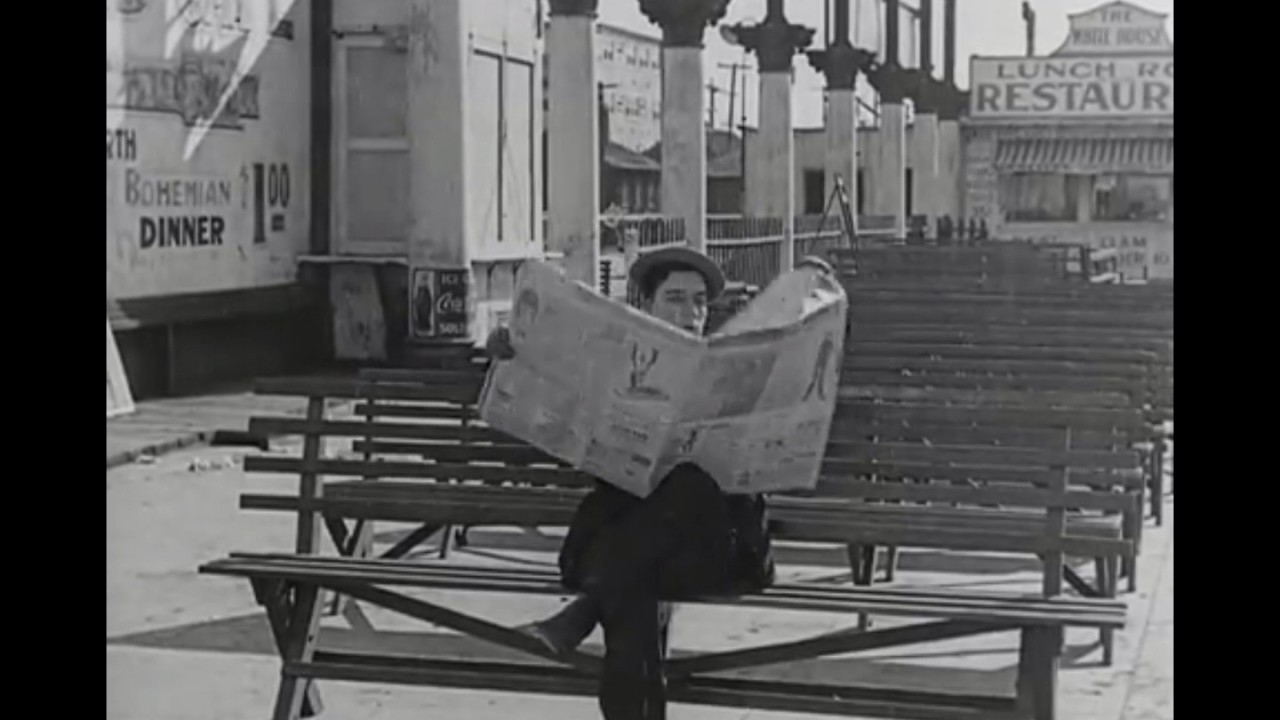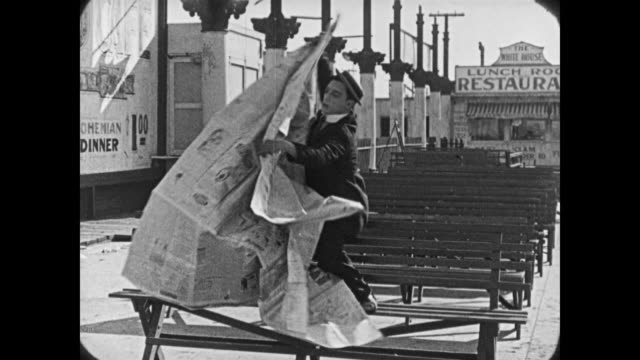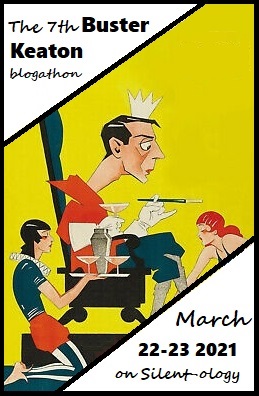When you watch Buster Keaton in a movie, you cannot help but wonder how he did what he did. Buster’s enduring comedy is evident in any number of pictures for even his lesser efforts illustrate his incredible athleticism and are testament to the chances he took for a laugh. And we cannot get enough of him.

When Silent-ology announced this year’s Buster Keaton Blogathon I immediately wanted to dedicate something to Buster’s work in 1921, 100 years ago. It just seemed a fabulous idea given Keaton released a truckload of enjoyable shorts co-directed with Edward Cline that year. These include The Boat, The Goat, The Haunted House (one of my favorites of his shorts), and The Playhouse (another great one). While Keaton’s best work was still ahead of him, 1921 was still two years out from his first feature, these shorts are divine. I decided to dedicate this entry to Hard Luck and The High Sign, released in March and April 1921 respectively. I had not seen these two in their entirety prior to planning this entry.
As a filmmaker, Buster Keaton had struck out on his own in 1920 releasing One Week as his first picture as director in August 1920. This was Buster’s first release without Arbuckle and it is considered by many to be his first masterpiece. By this point, Buster was a vaudeville veteran as well as a veteran of a World War. He had also been making pictures for years with over a dozen shorts with Arbuckle. Upon returning from the War, Keaton learned that Arbuckle was leaving the Comique Film Corporation for Paramount, where he would be the first silent comedian to switch from shorts to features. Producer Joseph Schenck offered Keaton his own Buster Keaton Studio, working out a deal with Metro Pictures to release eight Keaton shorts a year. One Week was the first to be released and set a high standard for subsequent Keaton shorts, but it was not the first to be filmed. That distinction goes to The High Sign.
Buster Keaton was disappointed in The High Sign, which is why the film was shelved and why he made and released One Week instead. Joseph Schenck released The High Sign after Keaton suffered a broken leg filming a sequence for the never-completed The Electric House. Keaton was so upset with The High Sign he actually left his studio to take a lead role in the Metro production The Saphead before starting in on his next project. The Saphead is the first feature film starring Keaton. Co-directed by Herbert Blaché and Winchell Smith, The Saphead is the first feature film starring Buster Keaton. Douglas Fairbanks, who had originated the role on Broadway, recommended Buster for the role.
During his ankle convalescence, Buster married actor Natalie Talmadge, sister-in-law of his boss Joseph Schenck and sister to the more famous Norma and Constance Talmadge. Buster and Natalie met when she worked as a script girl and secretary to Roscoe Arbuckle at Comique. The couple had two sons, James and Robert, but the marriage would not last.
Despite Buster’s disappointment in the movie, The High Sign was released because Schenck needed a film to release. While The High Sign does not measure up to One Week, there are several terrific gags and sequences in it. A favorite takes place early when Buster sits to read a newspaper that he opens slowly to reveal it is the size of a big rug.


Written and directed by Keaton and Edward F. Cline, in The High Sign we see Buster as an out-of-work drifter who sees an ad for an amusement park shooting gallery job for which he applies. After convincing people he is an expert shooter by cheating, Buster is hired by ‘The Blinking Blizzards’ criminal gang to kill a man who also hires him for protection. It is a convoluted plot, but fun ensues until a fantastic chase scene at the end in a house rigged with trap doors, flexible floors, secret passageways, movable windows, and what-have-you. The sequence is beautifully designed and choreographed.
Released a month before The High Sign, Hard Luck is said to be Buster Keaton’s favorite of his shorts because what turns out to be the final gag in the film got the biggest laugh of his career. It is a doozy. Also writter and directed by Buster and Eddie Cline, Hard Luck shows Buster as a young man who loses his girl and his job. Depressed, the young man is intent on ending his life and tries to do so in a series of funny failed attempts. After drinking whiskey disguised as poison, Buster ends up going on an expedition because he’s been on a “branch of the zoo,” impressing scientists but what Buster meant was he tried to hang himself on a branch of the zoo. Anyway, the expedition has him trying to find the only animal the zoo does not have, an armadillo. After a series of adventures, Buster ends up at a pool where he does a long, deep dive missing the pool and disappearing into a hole in the ground. Fast forward to years later, we see Buster reemerging from the hole dressed in Chinese garb accompanied by his Chinese wife and children.


Hard Luck was thought lost for years, but you can now watch it, along with many of Buster’s shorts in Kino Lorber’s Buster Keaton: The Shorts Collection, which I highly recommend.
As I mentioned earlier in the post, it is hard to believe that Buster’s comedy is now one hundred years old, or, that in one hundred years comedy has not been able to improve on his. Today, more than thirty years after his death, Buster Keaton’s films are as funny, touching, and relevant as ever. He was the master that everyone says he was, one of the most admired screen comedians who ever lived. Perhaps Buster Keaton is the truest example of someone who was born to entertain as came to be on that early October 1895 day between acts of his parents’ vaudeville show.
Now head on over to Silent-Ology and the seventh iteration of The Buster Keaton Blogathon. My humble post is only the tip of the Buster iceberg. Laughs and legend await.

“Today, more than thirty years after his death, Buster Keaton’s films are as funny, touching, and relevant as ever.”
How true the above quote is! Buster will never be outdated! You certainly did him proud in your post!
Thank you for your comments. He was a genius.
He certainly was!
A wonderful tribute to the enduring work of Buster Keaton. One hundred years ago! My, how time flies.
It is one of the few guarantees in life that when we are enjoying Buster Keaton movies in a theatre with a packed house, we will be sharing the joy of laughter.
Thank you, Paddy. Buster does bring us together. Wish he’d known. I think he believed his movies were of the past.
Thanks so much for contributing this piece to the blogathon, Aurora! I also love recognizing films’ 100th anniversaries, there’s something about that milestone that gives them a certain stature. And you’re right that some of Buster’s funniest work was in 1921.
You know, I think I like THE HIGH SIGN more than HARD LUCK, Buster’s misgivings aside. 😉 That Al St. John cameo, though.
Thanks, Lea. This is a terrific event. THE HIGH SIGN is a bit more memorable, I think. That final sequence is amazing.
Oh my, I meant to add–this is kind of essential–that you are the winner of this year’s blogathon drawing! 😀 (I’m not a morning person) Congratulations! The prize this year is the book Buster Keaton: Interviews, which is excellent. Feel free to contact me via https://silentology.wordpress.com/about-silentology/ so we can get address details, etc!
Oh, wow!!! Thank you. I’m thrilled! And I’m not a morning person either so I get it. ☺️
It is really amazing that, in 100 years, comedy has not outdone Buster Keaton. It’s quite shocking that he didn’t like The High Sign, I watched it recently and loved it. It’s a comedy masterpiece made by a 25-year-old! It also reminds me that in his autobiography Buster says he’d like to have been an engineer if he weren’t a performer. In The High Sign and some other movies (One Week, The Scarecrow…) he kind of fulfilled his dream.
Cheers!
Le
Hi Aurora. I enjoyed your essay. “The High Sign” and “Hard Luck” are two of the most interesting films in the series. I remember when “The High Sign” was still considered to be lost.